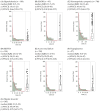Evaluation of Adverse Events Associated with the Sulfamethoxazole/Trimethoprim Combination Drug
- PMID: 40725512
- PMCID: PMC12295523
- DOI: 10.3390/jcm14144819
Evaluation of Adverse Events Associated with the Sulfamethoxazole/Trimethoprim Combination Drug
Abstract
Background/Objectives: The combination drug sulfamethoxazole/trimethoprim (ST) is a broad-spectrum antibiotic used against various infections; however, it is associated with several serious adverse events. The ST package inserts contain warnings about these adverse events. However, warnings vary internationally, and specific measures to address ST-related adverse events are unclear. Therefore, we aimed to comprehensively evaluate ST-related adverse events using the Japanese Adverse Drug Event Report (JADER) database and analyze the onset time for each event. Methods: Adverse events due to ST were analyzed using the JADER database between April 2004 and June 2023. The reported odds ratio and 95% confidence interval (95% confidence interval [CI]) were calculated, with a signal detected if the 95% CI lower limit exceeded 1. The Weibull distribution was used to characterize the onset time of adverse events with detected signals. Results: The total number of cases in the JADER database during the study period was 862,952, and the number of adverse events involving ST as a suspected drug was 4203. Adverse events associated with ST include hyperkalemia, syndrome of inappropriate antidiuretic hormone secretion, hematopoietic cytopenia, acute renal failure, hypoglycemia, disseminated intravascular coagulation syndrome, hepatic disorder, and the Stevens-Johnson syndrome/toxic epidermal necrolysis. Conclusions: Weibull analysis indicated an early failure-type onset time for all adverse events, suggesting the need for intensive adverse event monitoring of ST, especially in the first month of use. These findings may support revising drug package inserts in Japan to better reflect the identified risks.
Keywords: Japanese adverse drug event report; Weibull; confidence intervals; spontaneous reporting system; sulfamethoxazole/trimethoprim.
Conflict of interest statement
The authors declare no conflicts of interest. The funding agency had no role in the design, execution, analysis, or interpretation of the data.
Figures




Similar articles
-
Systemic interventions for treatment of Stevens-Johnson syndrome (SJS), toxic epidermal necrolysis (TEN), and SJS/TEN overlap syndrome.Cochrane Database Syst Rev. 2022 Mar 11;3(3):CD013130. doi: 10.1002/14651858.CD013130.pub2. Cochrane Database Syst Rev. 2022. PMID: 35274741 Free PMC article.
-
Antibiotic prophylaxis to prevent spontaneous bacterial peritonitis in people with liver cirrhosis: a network meta-analysis.Cochrane Database Syst Rev. 2020 Jan 16;1(1):CD013125. doi: 10.1002/14651858.CD013125.pub2. Cochrane Database Syst Rev. 2020. PMID: 31978256 Free PMC article.
-
Sertindole for schizophrenia.Cochrane Database Syst Rev. 2005 Jul 20;2005(3):CD001715. doi: 10.1002/14651858.CD001715.pub2. Cochrane Database Syst Rev. 2005. PMID: 16034864 Free PMC article.
-
Non-contraceptive oestrogen-containing preparations for controlling symptoms of premenstrual syndrome.Cochrane Database Syst Rev. 2017 Mar 3;3(3):CD010503. doi: 10.1002/14651858.CD010503.pub2. Cochrane Database Syst Rev. 2017. PMID: 28257559 Free PMC article.
-
Beta-blockers in patients without heart failure after myocardial infarction.Cochrane Database Syst Rev. 2021 Nov 5;11(11):CD012565. doi: 10.1002/14651858.CD012565.pub2. Cochrane Database Syst Rev. 2021. PMID: 34739733 Free PMC article.
References
-
- Kitazawa T., Seo K., Yoshino Y., Asako K., Kikuchi H., Kono H., Ota Y. Efficacies of atovaquone, pentamidine, and trimethoprim/sulfamethoxazole for the prevention of Pneumocystis jirovecii pneumonia in patients with connective tissue diseases. J. Infect. Chemother. 2019;25:351–354. doi: 10.1016/j.jiac.2019.01.005. - DOI - PubMed
-
- Haseeb A., Abourehab M.A.S., Almalki W.A., Almontashri A.M., Bajawi S.A., Aljoaid A.M., Alsahabi B.M., Algethamy M., AlQarni A., Iqbal M.S., et al. Trimethoprim-sulfamethoxazole (bactrim) dose optimization in Pneumocystis jirovecii Pneumonia (PCP) management: A systematic review. Int. J. Environ. Res. Public Health. 2022;19:2833. doi: 10.3390/ijerph19052833. - DOI - PMC - PubMed
Grants and funding
LinkOut - more resources
Full Text Sources
Miscellaneous

